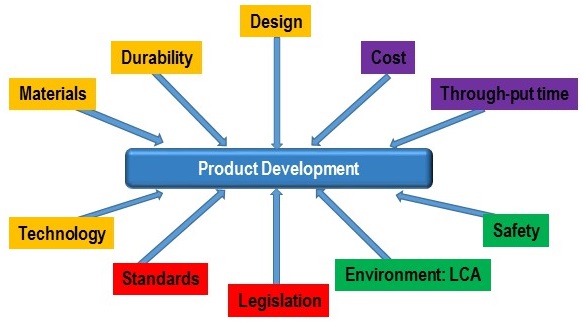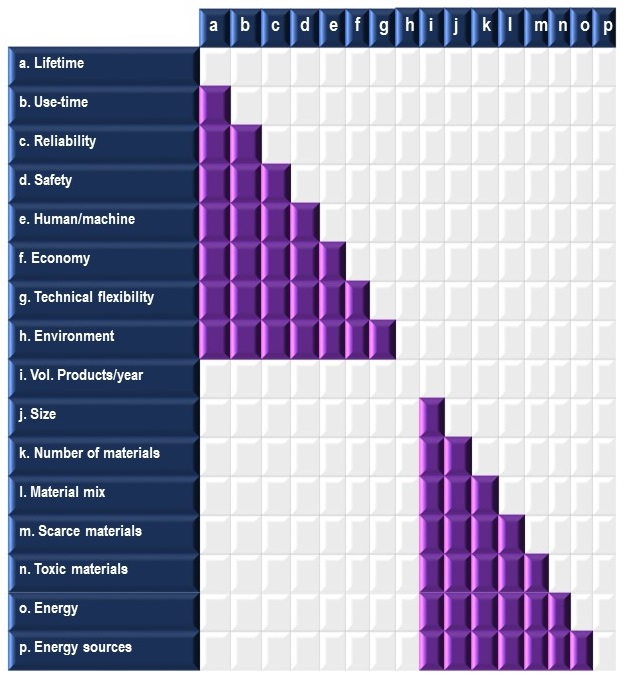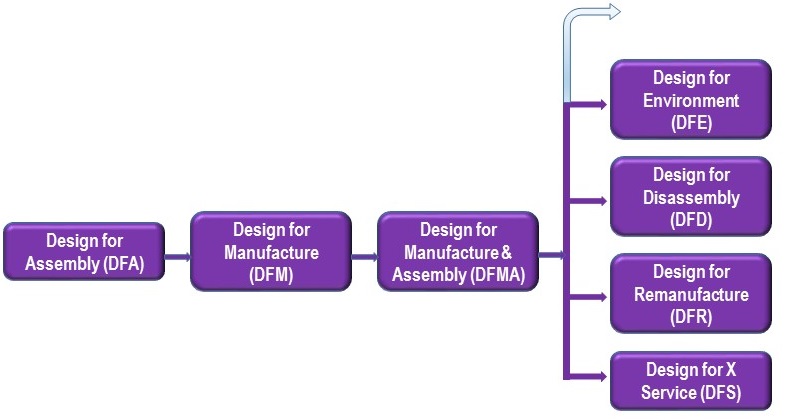Where to start?
By now, we have discussed the importance of planning from many different angles; it is this stage that will eventually determine cost, properties, and product performance. In the Hauschild et al. (2005) paper, sustainable product development is presented as an optimization exercise. This is best summarized in the paper in Figure 8, which has been reproduced below as Figure 6.1.

Figure 6.1 Engineering/manufacturing, social, environmental, and economic requirements of product design.
Click for text description.
Surrounding the Product Development box, like numbers on a clock, are 10 boxes. Each of the 10 boxes has an arrow pointing from it to the Product Development box at the center. The 10 boxes are as follows:
- Technology
- Materials
- Durability
- Design
- Cost
- Through-put time
- Safety
- Environment: LCA
- Legislation
- Standards
Credit: Modified from Figure 8 in Hauschild et al. (2005).

Figure 6.2
Figure 6.2 The ecofunction matrix. Click for a text description.
| -- | a | b | c | d | e | f | g | h | i | j | k | l | m | n | o | p |
|---|---|---|---|---|---|---|---|---|---|---|---|---|---|---|---|---|
| a. Lifetime | ||||||||||||||||
| b. Use-time | X | |||||||||||||||
| c. Reliability | X | X | ||||||||||||||
| d. Safety | X | X | X | |||||||||||||
| e. Human/machine | X | X | X | X | ||||||||||||
| f. Economy | X | X | X | X | X | |||||||||||
| g. Technical flexibility | X | X | X | X | X | X | ||||||||||
| h. Environment | X | X | X | X | X | X | X | |||||||||
| i. Vol. Products/year | ||||||||||||||||
| j. Size | X | |||||||||||||||
| k. Number of materials | X | X | ||||||||||||||
| l. Material mix | X | X | X | |||||||||||||
| m. Scarce materials | X | X | X | X | ||||||||||||
| n. Toxic materials | X | X | X | X | X | |||||||||||
| o. Energy | X | X | X | X | X | X | ||||||||||
| p. Energy Sources | X | X | X | X | X | X | X |
Credit: Modified from Figure 10 in Hauschild et al. (2005).
Given the intrinsic complexity of product development that takes into account so many different variables, the process is greatly benefited from use of the PLAN => DO => CHECK => ACT loop, as well as from flowchart analysis.

Figure 6.3
Click for text description.
This is a flow chart that begins on the left with a box entitled "Design for Assembly (DFA)." An arrow leads from this box to the right, where the next box is entitled "Design for Manufacture (DFM). To the right of the "Design for Manufacture (DFM)" box is the "Design for Manufacture & Assembly (DFMA)" box. To the right of the "Design for Manufacture & Assembly (DFMA)" box, with an arrow leading from the DFMA box, is a multi-pronged structure. There are four boxes in this structure, and they are arranged in a vertical fashion. Each of the boxes is preceded by an arrow pointing at its left edge. From bottom to top, the boxes are labeled as follows: "Design for X Service (DFS)," "Design for Remanufacture (DFR)," "Design for Disassembly (DFD)," and "Design for Environment (DFE)." The multi-pronged structure continues above the "Design for Environment (DFE)" box, with an arrow that points to the blank space above the "Design for Environment (DFE)" box.
- Designing for ease of purifying, to ensure that the purifying process does not damage the environment.
- Designing for ease of testing and classifying, to make it clear as to the condition of parts that can be reused and to enable easy classification of parts through proper markings.
- Designing for ease of reconditioning, supporting the reprocessing of parts by providing additional material as well as gripping and adjusting features.
- Designing for ease of re-assembly, to provide easy assembly for reconditioned and new parts.
